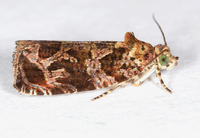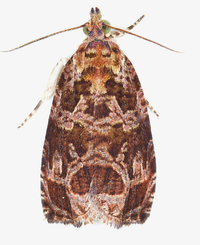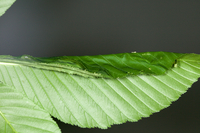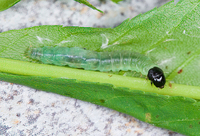Identification
Adult Markings: Olethreutes appalachiana is one of several Olethreutes species that feed on buckeyes. The medial fascia and patches on the forewing are brown and the areas between typically have a rosy-pinkish cast. The second segment of the palp has two black dots laterally, and the forewing base has a complete brown patch that extends across the wing. The following detailed description is based on that of Braun (1951). Olethreutes appalachiana is very similar to O. hippocastanum , but in the latter the dark basal patch is typically divided longitudinally into two or more fragments. In addition, the underside of the hindwing is mottled with fuscous shading in the costal and apical areas, as opposed to being conspicuously arranged in transverse bars, as seen in O. appalachianum . The presence of two brown to blackish spots of the outside of the second palp segment may be distinctive for this species since Kearfott (1907) did not mention these in his original description of O. hippocastanum that was based on six reared specimens from the Black Mountains in Buncombe County. Male and female genitalia are not very useful in separating the two species, but the length of the lobes on either side of the ostium may be useful in distinguishing between these species (Braun, 1951) and needs further verification.
Forewing Length: 8.5-10.5 mm (Gilligan et al., 2008).
Adult Structural Features: Braun (1951) and Gilligan et al. (2008) have illustrations of the male and female genitalia.
Adult ID Requirements: Identifiable from photos showing hindwings, abdomen, or other specialized views [e.g., frons, palps, antennae, undersides].
Immatures and Development: The larvae feed on Yellow Buckeye and are leaf rollers and tiers. The early-instar larva cuts the petiole of a leaflet, which causes it to droop and wilt. The larva initially feeds within the folded, young, wilted leaflet, then later cuts the petiole of a second leaflet, which is then folded within a third leaflet to form a more complex feeding shelter. In some cases the entire compound leaf may eventually be used in the feeding process (Braun, 1951). The older larvae have a bluish-green to greenish body and a jet black head and prothoracic shield. Braun (1951) found the larvae from the latter half of April into early-May.
Larvae ID Requirements: Identifiable only through rearing to adulthood.

 »
»




 »
»


